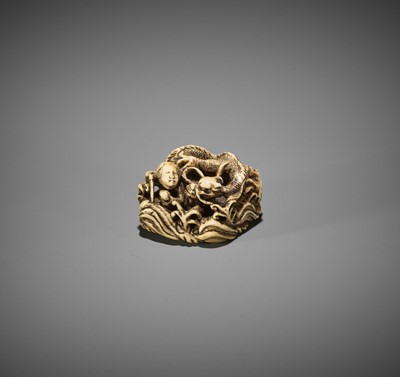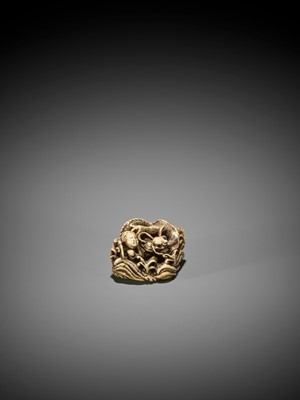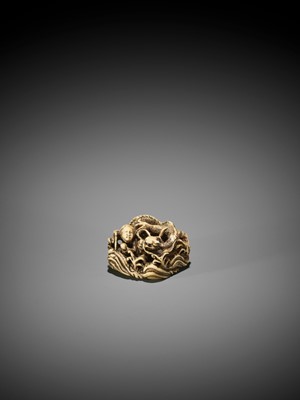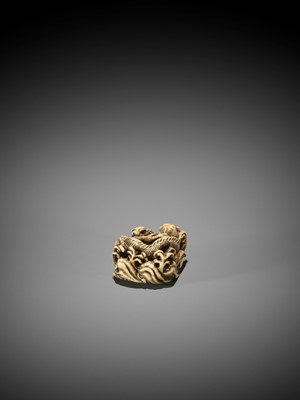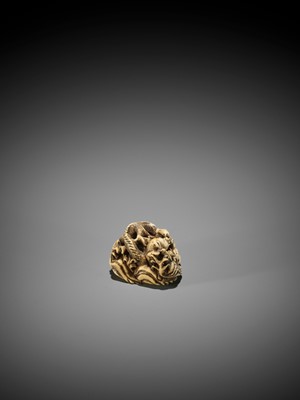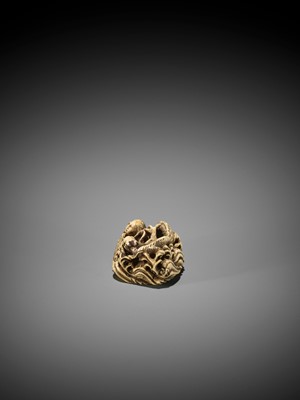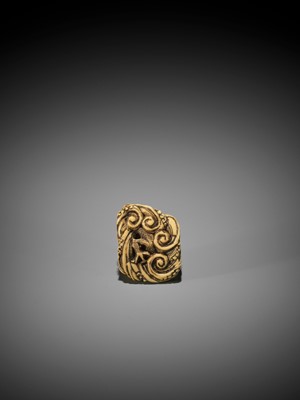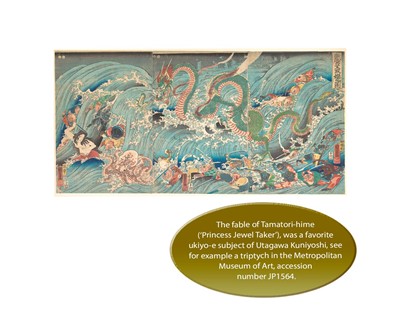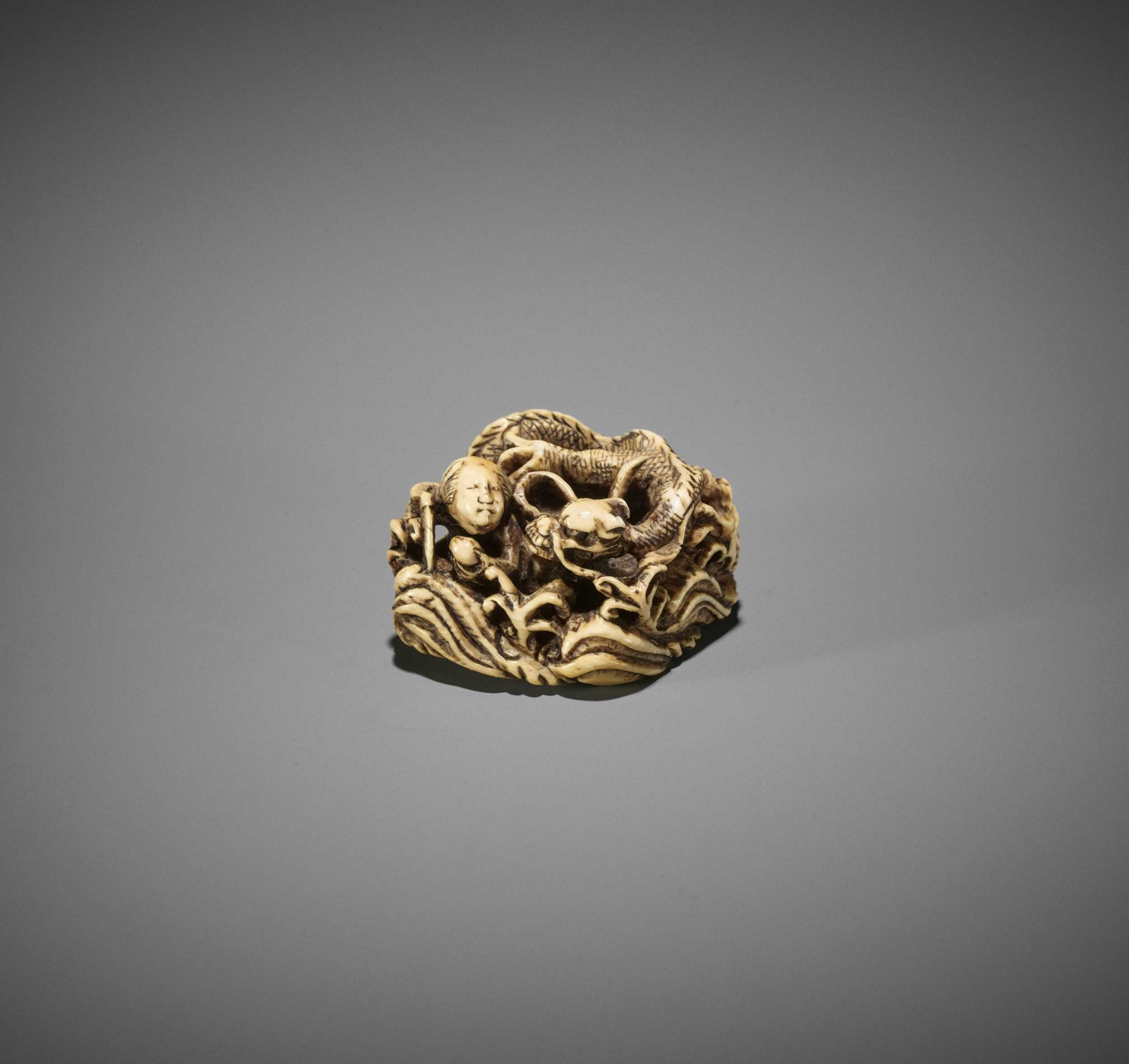16th Apr, 2021 13:00
Fine Netsuke & Sagemono
189
Ɏ A RARE EDO SCHOOL IVORY NETSUKE OF TAMATORI-HIME (‘PRINCESS JEWEL TAKER’)
Sold for €1,159
including Buyer's Premium
Unsigned
Japan, Edo (Tokyo), first half of 19th century, Edo period (1615-1868)
Carved in sukashibori (openwork) with the ama holding the precious jewel (Menkai fuhai no tama) in one hand and a pearl knife in the other, as a fierce dragon approaches her, all amid scrolling and crashing waves. Two himotoshi to either side of one of the dragon’s legs to the underside.
HEIGHT 3.4 cm, LENGTH 4.6 cm
Condition: Good condition with minor wear, few minuscule nicks and small natural age cracks.
Provenance: Ex-collection Jury Kolodotschko.
Laura Miller writes, “[the] legend of Princess Tamatori (Tamatorihime), or Ama, developed around the historical figure Fujiwara no Kamatari (614–69), who was the founder of the powerful Fujiwara clan. Upon Kamatari’s death, the Tang dynasty emperor, who had received Kamatari’s beautiful daughter as a consort, sent three priceless treasures to Japan in order to comfort his grieving lover by honoring her father. One of the treasures, a pearl, was stolen by the dragon king during a storm on its way to Japan in the inlet of Fusazaki. Kamatari’s son Fujiwara no Fuhito (659–720) went in search of the pearl to the isolated area where he met and married a beautiful pearl diver named Ama, who bore him a son. Ama, full of love for their son, vowed to help recover the stolen pearl. After many failed attempts, Ama was finally successful when the dragon and grotesque creatures guarding it were lulled to sleep by music. Upon reclaiming the treasure, she came under pursuit by the awakened sea creatures. She cut open her breast to place the pearl inside for safekeeping the resulting flow of blood clouded the water and aided her escape. She died from the resulting wound but is revered for her selfless act of sacrifice for her husband Fuhito and their son.” (Competition and Collaboration: Japanese Prints of the Utagawa School, 2007, p. 137)
Literature comparison:
The fable of Tamatori-hime (‘Princess Jewel Taker’), was a favorite ukiyo-e subject of Utagawa Kuniyoshi, see for example a triptych in the Metropolitan Museum of Art, accession number JP1564.
Unsigned
Japan, Edo (Tokyo), first half of 19th century, Edo period (1615-1868)
Carved in sukashibori (openwork) with the ama holding the precious jewel (Menkai fuhai no tama) in one hand and a pearl knife in the other, as a fierce dragon approaches her, all amid scrolling and crashing waves. Two himotoshi to either side of one of the dragon’s legs to the underside.
HEIGHT 3.4 cm, LENGTH 4.6 cm
Condition: Good condition with minor wear, few minuscule nicks and small natural age cracks.
Provenance: Ex-collection Jury Kolodotschko.
Laura Miller writes, “[the] legend of Princess Tamatori (Tamatorihime), or Ama, developed around the historical figure Fujiwara no Kamatari (614–69), who was the founder of the powerful Fujiwara clan. Upon Kamatari’s death, the Tang dynasty emperor, who had received Kamatari’s beautiful daughter as a consort, sent three priceless treasures to Japan in order to comfort his grieving lover by honoring her father. One of the treasures, a pearl, was stolen by the dragon king during a storm on its way to Japan in the inlet of Fusazaki. Kamatari’s son Fujiwara no Fuhito (659–720) went in search of the pearl to the isolated area where he met and married a beautiful pearl diver named Ama, who bore him a son. Ama, full of love for their son, vowed to help recover the stolen pearl. After many failed attempts, Ama was finally successful when the dragon and grotesque creatures guarding it were lulled to sleep by music. Upon reclaiming the treasure, she came under pursuit by the awakened sea creatures. She cut open her breast to place the pearl inside for safekeeping the resulting flow of blood clouded the water and aided her escape. She died from the resulting wound but is revered for her selfless act of sacrifice for her husband Fuhito and their son.” (Competition and Collaboration: Japanese Prints of the Utagawa School, 2007, p. 137)
Literature comparison:
The fable of Tamatori-hime (‘Princess Jewel Taker’), was a favorite ukiyo-e subject of Utagawa Kuniyoshi, see for example a triptych in the Metropolitan Museum of Art, accession number JP1564.
Zacke Live Online Bidding
Our online bidding platform makes it easier than ever to bid in our auctions! When you bid through our website, you can take advantage of our premium buyer's terms without incurring any additional online bidding surcharges.
To bid live online, you'll need to create an online account. Once your account is created and your identity is verified, you can register to bid in an auction up to 12 hours before the auction begins.
Intended Spend and Bid Limits
When you register to bid in an online auction, you will need to share your intended maximum spending budget for the auction. We will then review your intended spend and set a bid limit for you. Once you have pre-registered for a live online auction, you can see your intended spend and bid limit by going to 'Account Settings' and clicking on 'Live Bidding Registrations'.
Your bid limit will be the maximum amount you can bid during the auction. Your bid limit is for the hammer price and is not affected by the buyer’s premium and VAT. For example, if you have a bid limit of €1,000 and place two winning bids for €300 and €200, then you will only be able to bid €500 for the rest of the auction. If you try to place a bid that is higher than €500, you will not be able to do so.
Online Absentee and Telephone Bids
You can now leave absentee and telephone bids on our website!
Absentee Bidding
Once you've created an account and your identity is verified, you can leave your absentee bid directly on the lot page. We will contact you when your bids have been confirmed.
Telephone Bidding
Once you've created an account and your identity is verified, you can leave telephone bids online. We will contact you when your bids have been confirmed.
Classic Absentee and Telephone Bidding Form
You can still submit absentee and telephone bids by email or fax if you prefer. Simply fill out the Absentee Bidding/Telephone bidding form and return it to us by email at office@zacke.at or by fax at +43 (1) 532 04 52 20. You can download the PDF from our Upcoming Auctions page.
How-To Guides
How to Create Your Personal Zacke Account
How to Register to Bid on Zacke Live
How to Leave Absentee Bids Online
How to Leave Telephone Bids Online
中文版本的操作指南
创建新账号
注册Zacke Live在线直播竞拍(免平台费)
缺席投标和电话投标
Third-Party Bidding
We partner with best-in-class third-party partners to make it easy for you to bid online in the channel of your choice. Please note that if you bid with one of our third-party online partners, then there will be a live bidding surcharge on top of your final purchase price. You can find all of our fees here. Here's a full list of our third-party partners:
- 51 Bid Live
- EpaiLive
- ArtFoxLive
- Invaluable
- LiveAuctioneers
- the-saleroom
- lot-tissimo
- Drouot
Please note that we place different auctions on different platforms. For example, in general, we only place Chinese art auctions on 51 Bid Live.
Bidding in Person
You must register to bid in person and will be assigned a paddle at the auction. Please contact us at office@zacke.at or +43 (1) 532 04 52 for the latest local health and safety guidelines.
